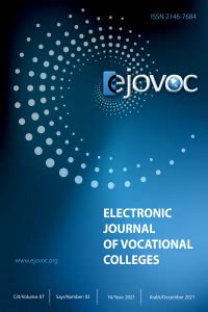GRİ İLİŞKİSEL ANALİZ YÖNTEMİ İLE YALITIM SEKTÖRÜNDE EN ETKİN TAŞERON FİRMA SEÇİMİ
Günümüz rekabet koşullarında işletmelerin özellikle
yönetim boyutunda yüz yüze geldiği çok değişkenli karar problemleri daha
karmaşık hâl almaktadır. Bu denli girift hale gelen karar problemlerinin çok
kriterli karar verme (ÇKKV) yöntemleri ile çözülmesi gerekli duruma gelmiştir.
Amaç:
Çalışmanın amacı, yalıtım sektörü işletmelerinin karşılaştığı karar
problemlerinin çözümü ve değerlendirilmesinde ÇKKV yöntemlerinin
kullanılabilirliğini göstermektir. Literatürde tedarikçi seçimine yönelik
birçok çalışma olmasına rağmen yalıtım sektöründe en etkin taşeron firma
seçimine yönelik çalışmaya rastlanmadığından bilimsel açıdan bu boşluğun
doldurulması amaçlanmıştır.
Veri Toplama ve Metodoloji: Çalışmanın uygulama kısmında Düzce ilinde yalıtım
sektöründe faaliyet gösteren bir işletme için ihtiyacı olan bir konuda en etkin
taşeron firmanın seçiminde gri ilişkisel analiz yöntemi kullanılmıştır. İlgili
veriler söz konusu işletmenin idarecilerinden sağlanmıştır. Bu kişiler aynı
zamanda karar vericiler olarak kabul edilmişlerdir.
Sonuç ve Değerlendirme: Gerçekleştirilen karar analizi neticesinde; en etkin
taşeron firma A5 (Hedef Metal) olmuştur. Sırası ile ikinci A4 (Özdoğan Metal)
ve üçüncü A3 (Hakoğlu) çıkmıştır. Bulunan analiz sonuçları söz konusu
işletmenin yetkilileri ile paylaşılmıştır. Bu konuda ileride yapılacak
çalışmalar için modelin genel yapısında değişikliklere gidilerek güncel
metotlar ve hibrit yöntemlerin kullanılabileceği ön görülmektedir.
Anahtar Kelimeler:
Çok Kriterli Karar Verme Yöntemleri, Gri İlişkisel Analiz, Yalıtım Sektörü İşletmeleri
Selectıon of the Most Effectıve Contractor Company in Insulatıon Sector wıth Grey Relational Analysıs Method
In today's competitive
conditions, multivariate decision problems frequently encountered by
enterprises are becoming more complex. It has become necessary to solve the
decision problems which have become so intrusive by using multi-criteria
decision making (MCDM) methods.
Objective: The aim of this
study is to demonstrate the availability of MCDM methods in the solution and
evaluation of decision problems encountered by the insulation sector
enterprises. Although there are many studies on the selection of suppliers in
the literature, there is no study of the most efficient subcontractor selection
in the insulation sector. It is aimed to fill this gap in terms of scientific.
Data Collection and
Methodology: In
the application part of the study, grey relational analysis method was used in
the selection of the most effective subcontractor for a company in the insulation
sector in Düzce province. The relevant data were obtained from the managers of
the enterprises. They were also considered as decision-makers.
Conclusion and
Evaluation: As
a result of the conducted decision analysis; the most effective subcontractor
was A5 (Hedef Metal). The second A4 (Özdoğan Metal) and the third A3 (Hakoğlu)
respectively. The results of the analysis were shared with the authorities of
the relevant enterprise. It is foreseen that, current methods and hybrid
methods can be used by making changes in the general structure of the model for
future studies.
Keywords:
Multi Criteria Decision Making Methods, Grey Relational Analysis, Insulation Sector Enterprises,
___
- Abbasianjahromi, H., Rajaie, H., Shakeri, E., (2013) A Framework for Subcontractor Selection in the Construction Industry, Journal of Civil Engineering and Management, 19(2), 158-168, Bedir, N, Yalçın, H, Özder, E, Eren, T. (2018). Çok Kriterli Karar Verme Yöntemleriyle Taşeron Firma Seçimi: Kırıkkale İlinde Bir Uygulama. Akademik Platform Mühendislik ve Fen Bilimleri Dergisi, 6 (2), 25-33. DOI: 10.21541/apjes.328325 Bedir, N., Özder, E. H., Eren, T., (2016) Course Selection with AHP & PROMETHEE Methods for Post Graduate Students: An Application in Kırıkkale University Graduate School of Natural and Applied Sciences, The 3rd International Conference on Industrial Engineering and Applications (ICIEA) in Hong Kong, during April, 28-30 Chan, J. ve Thomas T., (2007). “Multi Criteria Material Selections And-Of-Life Product Strategy: Grey Relation Analysis Approach”, Materials and Design, Cilt 28, Sayı 5, S.1539-1546. Deng, Julong L. (1989). “Introduction to Grey System”, the Journal of Grey System, Cilt 1 Sayı 1, S.1O24. Dinç, D. (2005). “İnşaat Projesi Yönetimi: Bir Baraj ve Hidroelektrik Santral Projesi Üzerine Uygulama”, Gazi Üniversitesi Fen Bilimleri Enstitüsü, Ankara Fong, S. W. &Choi, K. Y. (2000). “Final contractor selection using the analytical hierarchy Process”, Construction Management and Economics 18: 547–557. Hatush, Z.ve Skitmore, M., (1998) “Contractor selection using multi criteria utility theory: an additive model" Building and environment, 33(2), 105-115 Herbert, C.P. & Biggart, T.P. (1993) “Kingsford Smith Airport, Sydney: planning and tendering the new parallel runway”. Proceedings of the Institution of Civil Engineers, 93, 182-9. Kazanjian, R., Drazin, R. & Glynn M., (2000) “Creativity and technological learning: the roles of organization architecture and crisis in large-scale projects”, Journal of Eng. Tech. Management, USA Opricovic, S., (1998) Multi criteria optimization of civil engineering systems, Faculty of Civil Engineering, Belgrade, 2(1), 5-21 Palaneeswaran, E., ve Kumaranswamy, M., (2000) “Contractor selection for design/build projects”, Journal of construction engineering and management. Peker, İ. ve Birdogan B., (2011), “Gri İlişkisel Analiz Yöntemi İle Türk Sigortacılık Sektöründe Performans Ölçümü”, Uluslararası İktisadi ve İdari İncelemeler Dergisi, Cilt 4, Sayı 7, S.1o17 Ravi, V., (2012) Selection of third-party reverse logistics providers for End-of Life computers using TOPSIS-AHP based approach, International Journal of Logistics Systems and Management, 11(1), 24-37 Singh, D., Tiong, R.L., (2005) A fuzzy decision framework for contractor selection, Journal of Construction Engineering and Management, 131(1), 62-70 Soner, S., Önüt, S., (2006) Multi-Criteria Supplier Selection: An ELECTRE-AHP Application, Sigma, 4, 110-120 Topçu, Y. I. (2004) “A decision model proposal for construction contractor selection in Turkey”, Building and Environment, 39(4), 469-481 Tzeng, G. H., Lin, C. W., Opricovic, S., (2005) Multi-criteria analysis of alternative-fuel buses for public transportation, Energy Policy, 33(11), 1373-1383. Üstünışık, N.Z. (2007). “Türkiye’de İller Be Bölgeler Bazında Sosyo Ekonomik Gelişmişlik Sıralaması Araştırması: Gri İlişkisel Analiz ve Uygulaması”, Yüksek Lisans Tezi, Gazi Üniversitesi Fen Bilimleri Enstitüsü, Ankara
- ISSN: 2146-7684
- Yayın Aralığı: Yılda 2 Sayı
- Başlangıç: 2011
- Yayıncı: Kırklareli Üniversitesi
Sayıdaki Diğer Makaleler
3D PRINTING TECHNOLOGY: METHODS AND MATERİALS
Hamidi AHMED, Zidour MOHAMED, Sadoune MOHAMED
MİMARİYİ SES İLE TASARLAMAK ÜZERİNE ÖĞRENCİ İZLENİMLERİ
ÇOK KRİTERLİ KARAR VERME YÖNTEMLERİ İLE EĞİTİM KURUMLARI KARAR PROBLEMLERİNİN ÇÖZÜMÜ
Hakan Murat ARSLAN, Adem KÖSE, İsmail DURAK
Yasin AKKUŞ, Çağatay AKDOĞAN, Ayşe AKYOL
TREYLER SEKTÖRÜNDE PATENT ÖN ARAŞTIRMA VE RAKİP İZLEME FAALİYETLERİ
INDUSTRY 4 AND INNOVATION IN PROCESS SAFETY OF SMART FACTORIES
AHP-TOPSIS TEKNİKLERİYLE KURULUŞ YERİ SEÇİMİ PROBLEMİNİN ÇÖZÜMÜ: BARIŞI DESTEKLEME HAREKATI ÖRNEĞİ
